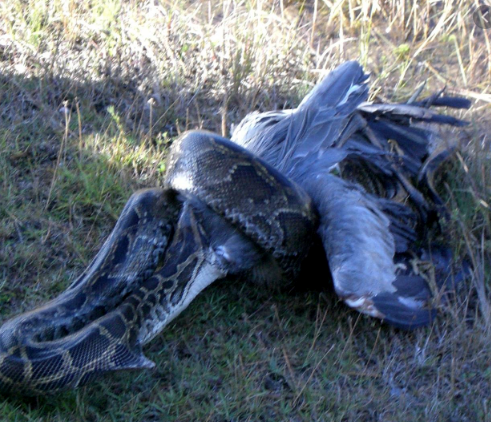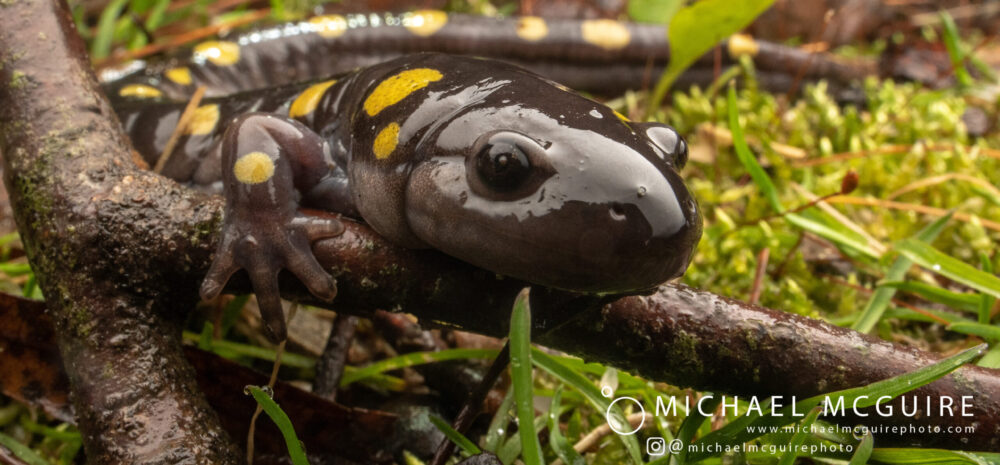By Mitch Maver
Across the globe, the introduction of exotic species is having catastrophic negative effects on the health of our planet’s natural ecosystems. Reptiles and amphibians are commonly caught and transported far from their native range to be sold as pets for humans. This practice has lead to the accidental, or in some cases intentional, introduction of exotic reptiles and amphibians into areas where they are not naturally found. In many locations, populations of exotic reptiles and amphibians have proliferated and are now reeking havoc on beloved local species. Invasive species disrupt natural ecosystems and can significantly reduce the biodiversity of an area. In other words, say goodbye to your beloved songbirds or deer because that pet snake your neighbor let “free” may become invasive and those charismatic local species could vanish from the landscape in the blink of an eye. Invasive predators can reduce the abundance of native species by eating them or by simply out-competing them for resources. This can then have a domino effect where the introduction of a single invasive species causes one effect which has another effect and so on until the next thing you know the whole ecosystem has collapsed. Unfortunately, this process, which in science terms is called a trophic cascade, is all to common across the globe.
Today, the invasive Burmese python, Python bivittatus, is a destructive force that is taking over Florida’s Everglades National Park. Populations of this huge invasive serpent have skyrocketed since they were first detected in the 1980s and 1990s. Although it is not known for sure, the invasion of Burmese pythons in south Florida is believed to be the result of humans releasing pet pythons, that they either did not want or could no longer care for, into the wild. Burmese pythons are native to southeast Asia and are one of the largest species of snakes on earth, reaching sizes of 23 feet! Because of their size, these snakes can feed on a wide range of species such as wading birds, small alligators, and mammals. Cases where the introduction of exotic reptiles has lead to significantly reduced biodiversity and localized extinctions of native species has historically only been observed on islands. However, in south Florida, the decline in opossum, raccoon, deer and other mammal populations has been attributed to the introduction of the Burmese python. Recent research in south Florida has provided evidence that Burmese pythons are currently causing a trophic cascade where direct reductions in mammal populations due to python predation is having indirect effects on non-prey species such as turtles. In other words, mammal populations in south Florida have decreased due to python predation to such an extent that there are now less animals, specifically raccoons, around to feed on the eggs of certain turtle species. In addition, it is believed that Burmese pythons are having an indirect impact on the vegetation dynamics of south Florida.

In a 2017 study, Dr. John D. Willson, of the University of Arkansas, and his research team examined how Burmese pythons are indirectly impacting south Florida ecosystems. The study hypothesized that predation rates, specifically on turtle eggs, would be lowest in the southern part of the Everglades National Park, where pythons have been established the longest and where mammals are rare. Dr. Willson constructed artificial turtle nests baited with quail eggs at 13 sites and used camera traps to monitor predator activity. The 13 sites were divided into three categories; “core” sites, areas where pythons have been detected the longest, “peripheral” sites, where pythons have only recently been detected, and “extralimital” sites, where breeding python populations have not been detected yet. The spatial distinction of the study design allowed Dr. Willson to examine what animal species were present and their abundance so that conclusions could be drawn regarding both the direct effects pythons have on mammals and the indirect effect that has on turtle nest predation.

Dr. Willson, and his research team, found that nest predation rates, and the observed number of species, were significantly greater at “extralimital” sites where python breeding is not yet believed to be occurring. Nest predation at “core” sites, where python populations have been established the longest, was low and only a few species of mammals were observed. In addition, the nest predation that did occur at “core” sites were done almost exclusively by crows. Whether or not the greater occurrence of crows at core nest sites compared to “peripheral” and “extralimital” sites can be attributed to decreased competition with the prey species of the Burmese python could not be “conclusively concluded based on the [Study’s] data”, says Dr. Willson. However, data from the camera traps at each site did indicate that the “spatial pattern of mammal abundance is inversely correlated with the spatial expansion of python population”. In layman’s terms, what Dr. Willson means by this is that mammal abundance was found to be lower in areas where pythons were abundant and higher in areas where pythons were less abundant. Furthermore, the results of the study supported the hypothesis that the decreased mammal populations caused by python predation is positively effecting the abundance of the non-prey species of the Burmese python. The study also refuted the previously suggested alternative hypothesis that the recent increase in the abundance of coyotes in the Everglades is driving the observed decline in mammal populations. So based on the findings of the study, Dr. Willson and his team concluded that a trophic cascade, where Burmese pythons are having a positive indirect effect on the recruitment of small egg-laying species by suppressing mammal populations, is occurring in the Everglades National Park. What this means is that more egg laying species, such as turtles, are surviving to adulthood because the pythons have eaten a large number of their predators.
Based on the conclusions Dr. Willson and his team were able to draw from the findings of this study, I asked him what he believes needs to be done next in order to mitigate the issues Burmese pythons are causing in south Florida. At the current moment, Dr. Willson believes that more extensive research is still needed and states how, in his mind, there are currently no “tools that can be used at a large-scale to do anything about this problem” because of how widely distributed pythons are in south Florida and how difficult they are to detect. Right now, the most effective way to mitigate Florida’s python problem is to work at a “small-scale and do things such as protect key area’s used by wading birds, and to keep python populations low in the Florida Keys where there are a lot of endemic species like the key deer, the lower keys marsh rabbit, and the Key Largo wood rat” says Dr. Willson. But, before any large-scale management plan can be implemented Dr. Willson is adamant that more research on control methods, such as python traps, needs to be done. He goes on to explain how on the island of Guam where invasive brown tree snakes lead to a significant loss of native fauna, well funded research regarding basic control methods, like traps and visual searches to remove tree snakes, has allowed researchers on the island to begin large scale removals and the reintroduction of native birds; something he would have said was impossible ten to fifteen years ago. “The solid research on the very basic level of how to detect [brown tree snakes] using very simple techniques basically laid the groundwork for large scale removals and we are just not doing that with [south Florida] pythons” says Dr. Willson. The main problem he currently sees in Florida is that “there is more pressure to present the visual of doing something rather than doing things that are less glamorous but actually inform our knowledge of the situation better”.
After gaining a better understanding of the current python problem in south Florida, I asked Dr. Willson if thinks Burmese pythons are affecting the Everglades ecosystem in ways that have not yet been examined. He mentions how, in his mind, pythons are most likely having some indirect effect on the area’s vegetation dynamics by suppressing populations of important herbivores such as rabbits and deer. Furthermore, he suspects that pythons are indirectly affecting the seed dispersal of fruit-forming plant species by reducing the abundance of seed dispersing mammals. In Guam, research regarding the invasive brown tree snake suggests that brown tree snake’s “are changing the forest by changing the recruitment, pollination, and seed dispersal of trees” says Dr. Willson. If a similar phenomenon is occurring in the Everglades, its very likely that the forest structure of the park will be different in future than how it has been historically which could have far reaching implications that can not yet be predicted. However, if wildlife managers in the Everglades take what has been learned on Guam, in regards to invasive snake management, in to account as the come up with there own python management strategies it is possible that further large scale changes to the ecosystem dynamics of the Everglades can be prevented. Lastly, Dr. Willson mentioned how there is a lack of knowledge regarding the effects pythons have on wading birds because of how hard it is to keep track of there populations. The knowledge gaps that still exists regarding the effects pythons have on vegetation and other organisms will be a major hurdle researchers and wildlife managers will have to get over before any large scale management plan can be implemented
To conclude the interview, Dr. Willson mentioned how the greatest challenge, when it comes to carrying out large-scale studies such as this one, is overcoming the very complex political and regulatory environment of south Florida. Since pythons are now so widely distributed across the region, to test his hypothesis meant he needed to include sites located on lands that are managed by several different entities. This made “the permitting required to conduct this study astronomically difficult to get organized” says Dr. Willson.
Dr. Willson’s full journal article can be found in volume 54 of the Journal of Applied Ecology on page 1251 or at https://besjournals.onlinelibrary.wiley.com/doi/full/10.1111/1365-2664.12844.
Work Cited
Gibbons, J. (2011) Invasive Burmese Pythons Are Taking a Toll on Florida’s Native Birds. Smithsonian Insider. Retrieved from https://insider.si.edu/2011/03/burmese-pythons-are-taking-a-toll-on-floridas-native-birds/
Willson, J. D. (2017) Indirect Effects of Invasive Burmese Pythons on Ecosystems in Southern Florida. Journal of Applied Ecology, 54, 1251-1258
Garcia, S. E. (2019) A 17-Foot Burmese Python Was Found in Florida. What Was It Even Doing There? The New York Times. Retrieved from https://www.nytimes.com/2019/04/08/us/python-florida.html
